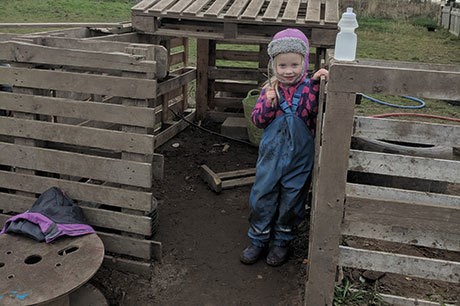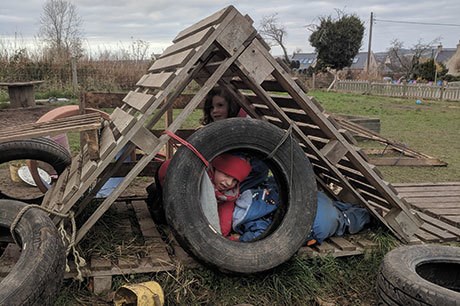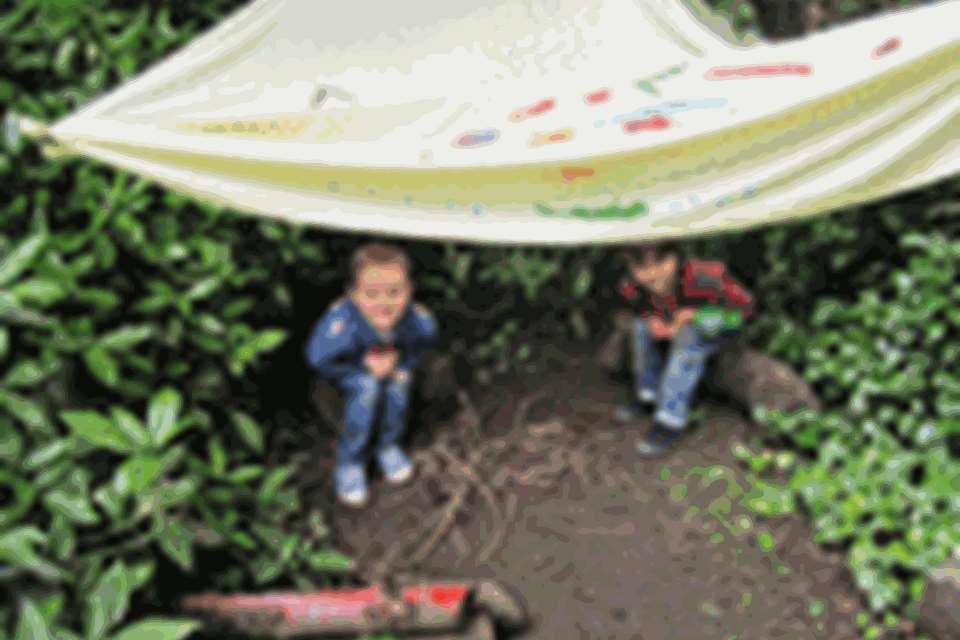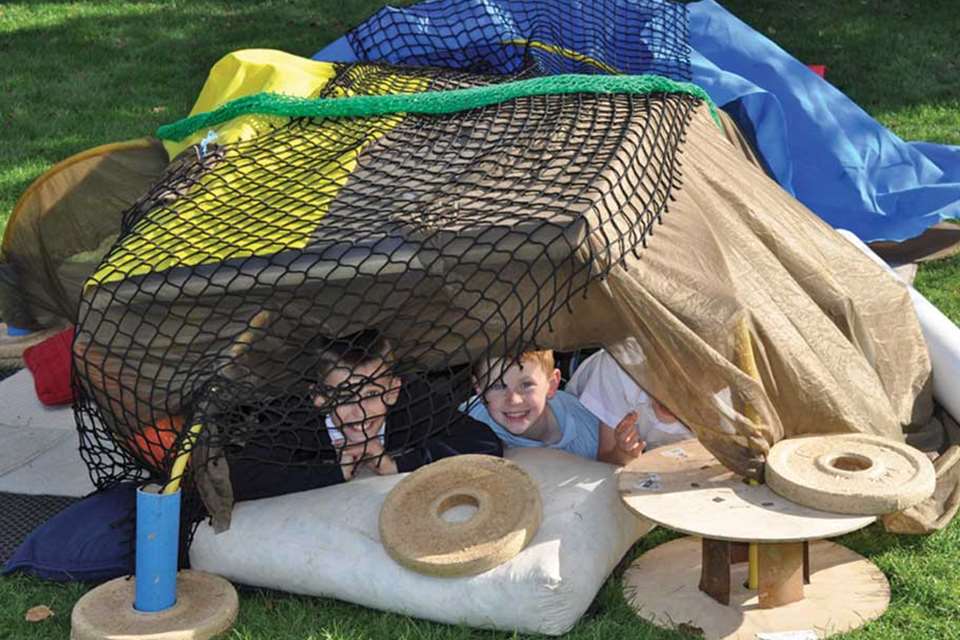Outdoors: Dens - Take cover!
Nicole Weinstein
Monday, January 21, 2019
An outdoor setting in the Scottish Highlands is giving children the resources and autonomy to take their den-building to a new level, Nicole Weinstein discovers

Download the PDF of this article
Children at Stramash Outdoor Nursery Elgin, which is one of a chain of four social enterprise nurseries in North-East Scotland, are not strangers to the art of den-building and creating secret hideaways. In fact, since moving to their new site earlier this year, they, together with staff, have transformed a one-acre open field into a space that houses dens for all occasions.
The temporary structures include ‘the cave’, which started off as a chicken coop but was so popular that the children reconfigured the wooden pallets and moved it to space near the mud kitchen. Another favourite is the giant nest, which was created out of fallen branches from the adjoining woodland, and was such an inviting area that it was used for daily circle time.
‘All the structures on the site – the washing area, the cloakroom, the nappy changing area, the rest area – are made by us with wooden pallets and tarpaulin for shelter,’ explains team leader Alastair Davidson. ‘The children are involved in daily safety checks and help us sand down wood, repair broken pieces of pallet and use the tools like hand saws to make new structures. It’s second nature to them and they often initiate new ideas for temporary dens based on their interests.’
NATURE’S HIDEAWAYS
 The tagline of this 32-place fully outdoor setting, which believes in a child-led and nature approach to learning, is ‘Freedom to learn, inspired by nature’.
The tagline of this 32-place fully outdoor setting, which believes in a child-led and nature approach to learning, is ‘Freedom to learn, inspired by nature’.
Mr Davidson says, ‘This is the children’s space; it’s their nursery and they have designed it with their own needs in mind, using the resources that we have to hand. The structures are flexible and change depending on their interests and other factors such as the weather.’
Cable drums, pallets, old tyres, pieces of rope, tarpaulin and a range of tools are the main resources used to build permanent and semi-permanent dens, and the local recycling centre is the main supplier of these items.
‘Sometimes the simplest thing becomes a den,’ says Mr Davidson. ‘An old compost crate, for example, has served so many different functions – it’s been a house, a car and a bunk bed, and its simple structure provides endless play opportunities.’
During the building of the chicken coop, it became obvious that the children loved using the structure to climb on and hide in, so it became their ‘cave’. It’s a simple structure made of seven heavy pallets held together with nails and stakes in the ground to secure it.
‘Children like to use these spaces to tell and act out their stories. Sometimes it can be about a child finding a special place that they can come to when feeling overwhelmed. So much of their day is controlled by an adult, but this is their nursery and when they have a plan we give them the support and freedom to put it into action,’ says Mr Davidson.
WHAT IS A DEN?
Practitioners at Elgin Stramash challenge the notion of a traditional den as a place or safety or offering protection from the elements, and give children the tools and opportunities to be more creative with their den-building.
‘A den can be anything,’ offers Mr Davidson. ‘Even sitting in the overgrowth, for example, can constitute den-building. It’s important that practitioners don’t push their idea of what a den should be onto the child because they often have their own clear idea. So, the role of the practitioner is to ask questions and allow the child to figure it out and then support them with the building, as they will not often have the physical dexterity to build all elements of it.’
THE GIANT NEST
One way to support children’s den-building is to start on a small scale, as was the case in the construction of the giant bird’s nest. Every day children feed the hens and collect the eggs, and they also stock up the bird feeders with seeds. In winter months, they rub pine cones with lard, roll seeds onto them and hang them in the surrounding trees.
One day, following the RSPB Bird Watching week, the children decided to build nests for the birds. They collected twigs, leaves and hay and placed their nests around the bird table, hoping to attract some of the birds.
‘Some of the children decided that they wanted to be birds themselves so they formed a group and started working together as a team to build a giant nest in the adjoining woodland,’ recounts Mr Davidson.
‘Luckily there was a large pile of branches that the woodcutters had recently cut down and the children hauled the wood to the circular area that was to form the nest. Practitioners helped to put the branches into place and the children then added hay, moss, leaves and twigs. Inside the nest, they lined it with hay to make it comfortable.
‘My daughter and her friends carried out imaginary play in the nest. A group of them were eggs and the others were hens pecking the eggs, which they had observed at the chicken coop. The eggs then hatched and the children gracefully flew out of the nest with their arms acting as wings.
‘It was a wonderful example of collaborative play and we found, as is often the case when building dens, that some of the more reluctant children to get involved socially often come out of their shells when working together in this way.’
About the setting
Stramash Outdoor Nursery Elgin moved to its current site in January 2018. The setting offers 32 places for children aged two to five years.
The new site is again based near a village hall which has access to running water. The hall has been used on three occasions over the past three years when there have been high winds.
It has a Scottish Outdoor Access Code agreement with the Forestry Commission, which means it can explore local woodland as long as it is responsible in terms of impact.
The site’s only enclosed indoor space is a tentipi, which houses a woodburner where food is cooked.
Top tips for den-building
Start small. Make dens for animals, teddies or fairies so that the children can visualise the materials and think about their purpose beforehand.
Avoid using ropes to tie together the branches as they can make a den seem more secure than it actually is.
Use Y-shaped sticks that lock together. Using the trunk of the tree as the main structure isn’t great as when it rains you’ll just get wet.
If children are interested, provide a pruning saw so that they can cut sticks to certain lengths.
MORE INFORMATION
- www.stramash.org.uk/info/outdoor-nursery
- RSPB, www.rspb.org.uk
- The Woodland Trust, www.woodlandtrust.org.uk
- Outdoor and Woodland Learning, www.owlscotland.org
- Essential Bushcraft by Ray Mears







